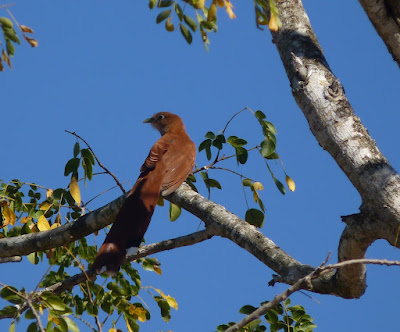A huge roadtrip to Colima and back this morning provided a few opportunities for birding...
The following sites were visited:
Laguna La Barca - A small lagoon between the towns of La Barca and Suhuayo
River at Tamazula - A fast flowing clean river (a rarity in Mexico) follows the road between Mazamitla and Tamazula, providing some good birding.
Laguna Cuyutlan - South of Manzanillo
Playa d'Oro road - North of Manzanillo, as described by Howell
Laguna La Maria - Camping spot on the slopes of Volcan de Fuego
Laguna La Barca
A brief 5-minute stop here was enough to catch views of American White Pelicans, Neotropic Cormorants, Great and Snowy Egrets, Great Blue Heron, American Coots, Common Moorhen, Northern Jacana, Caspian Tern, Laughing Gull, American Wigeon, Northern Shoveler and Blue-winged Teal.
A longer explore would reveal a lot more birds, but this isn't the nicest spot in Mexico, plagued by litter and youths shooting wildlife with pellet guns.
Rio at Tamazula
Again, only a brief stop at this picturesque spot. Managed to find Green Kingfishers, Spotted Sandpipers, Striated Heron, Black-necked Stilts. Also close by, 60 feeding Black Vultures.
Volcan de Fuego slopes
We followed Howell's directions from Atenquique, but unfortunately the track was blocked off after about 6km, meaning we had no access to the higher slopes. On the lower slopes were Thick-billed Kingbirds, Chipping and Lark Sparrows, Varied Buntings, Grey Silky, Black-headed Grosbeak, Bumblebee Hummingbird, Hooded and Streak-backed Orioles, Greater Peewee, Acorn Woodpecker, Orange-crowned, Wilson's, Audubon's, and Blue-throated Grey Warblers.
Cuyutlan - Lagoon and Beach
On the beach at Cuyutlan was a nice Whimbrel, and out to Sea were familiar birds of the Pacific Coast - Magnificent Frigatebirds, Brown Pelicans, Elegant Terns and a nice bonus, a flock of 7 Tricoloured Herons.
A very brief stop at the lagoon turned up Blue-Grey Gnatcatchers, a Yellow-breasted Chat, huge numbers of Herons including Great Blue, Little Blue, Tricoloured and Reddish, Snowy, Cattle and Great Egret. Also present were Anhingas and Neotropical Cormorants.
The coastal scrub around Cuyutlan town threw up a few more interesting species, including MacGillivray's Warbler, Nashville Warbler (many), Orchard Oriole, Lineated Woodpecker, Yellow Warbler, Common Ground and Ruddy Ground Doves.
Playa d'Oro
All these sections were rushed as I only had a few hours to spare on Sunday morning. Still the potential of this stretch was immense. With only minimal stopping I found Squirrel Cuckoo, Yellow-winged Caciques, Groove-billed Anis, Golden-cheeked Woodpeckers, Great Kiskadees, Social Flycatchers, White-bellied and Happy Wrens, Masked Tityras, Stripe-headed Sparrows, Rose-throated Becards, West Mexican Chachalacas, 2 soaring Wood Storks and a whole lot more.
Laguna La Maria
The trip ended with some fantastic birding at this camping site. Though busy in the afternoon with holidaying Mexicans, first thing Monday morning was magical. Birds here included Orange-billed Nightingale Thrush, Slate-throated Redstart, Tufted Flycatcher, Rusty-crowned Ground Sparrow, Least Grebe, Plumbeous, Warbling, Black-capped and Golden Vireoes, Smoky-brown, Grey-crowned, Ladder-backed and Golden-cheeked Woodpeckers, Northern Waterthrush, Louisiana Waterthrush, Ovenbird, Flame-coloured and Red-headed Tanagers, Ivory-billed Woodcreeper, Blue Mockingbird, Vaux's Swift and a whole lot of others.
Perhaps the highlight was picking out a Lesser Roadrunner on the road back to Comala.









 In Mexico, these are known as 'tlacuaches'. Apparently people eat their tails to improve fertility.
In Mexico, these are known as 'tlacuaches'. Apparently people eat their tails to improve fertility. 










































